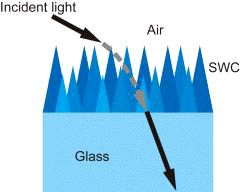Prepress
Canon announces new anti-reflective lens coating technology

Thursday 18. September 2008 - Canon Inc. today announced the development of Subwavelength Structure Coating (SWC), a new coating technology for camera lenses that minimizes ghosting and flare caused by reflected light. SWC is used in Canon's concurrently announced large-diameter, wide-angle EF24mm F/1.4L II USM lens for EOS-series SLR cameras.
Reflections are caused by large changes in the refractive index of light at the glass-air boundary on the surface of a lens. To date, efforts to take advantage of light interference and minimize reflections have consisted of applying a thin film of coating onto the lens surface, but this approach can fail to provide adequate protection depending on factors like the light’s angle of incidence, and sometimes leads to ghosting and flare.
Canon’s special SWC coating, a new type of anti-reflection technology, minimizes reflections by aligning countless wedge-shaped structures more minute than the wavelength of visible light on the surface of a camera lens.
These wedges continuously change the refractive index of light at the glass-air boundary of the lens, thereby eliminating the boundary where the index undergoes large changes. This lack of large change in the refractive index drastically reduces reflections. SWC therefore realizes superior anti-reflective capabilities in environments where previous coating technologies could not, particularly in situations involving light with a large angle of incidence.
Utilizing SWC technology on large-curvature lens elements, which are mainly found in wide-angle lenses, will significantly minimize the occurrence of ghosting and flare caused by reflected light in environments that have posed problems in the past.
Canon will offer high-performance lenses that deliver excellent image quality by actively incorporating SWC technology in future lenses, especially those containing large-curvature lens elements.
